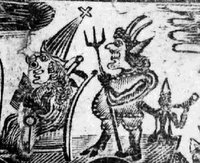New Carnivalesque!
Carnivalesque #10 is up at Early Modern Notes! There's plenty of good stuff for all historical tastes, with a particular emphasis on plots, Gunpowder and otherwise, and early modern court records (a particular favorite with me). Check it out!
Blogger was down for most of yesterday afternoon, and although (a)musings was viewable by early evening, I still couldn't post until much later in the evening, at which point I was at a Guy Fawkes Day Effigy-Burning party and in no condition to actually post the following:
Pope's Day in Boston
Remember, remember, the fifth of November took on a new ritual life in Boston. By the middle of the eighteenth century, the traditional English effigy-burning had evolved into a city-wide festival marked by battles between the North End's and the South End's apprentices and artisans. The "lower orders" in each part of the city made effigies of the Pope, Devil, and Pretender and then tried to capture and burn each other's effigies. The riots were certainly anti-Catholic but also served another purpose. Resistance to the Stamp Tax in 1765-66 was built on networks of communication and leadership already in place to coordinate "organized" Pope's Day rioting. Ironically, what was a celebration of English, Protestant identity, and by extension, a celebration of Parliamentary and monarchical authority, helped foment revolution against those very institutions.
Pope's Day effigy-burning died out during the Revolution in favor of commemorations of Redcoat evils. Bostonians now remembered the Boston Massacre and the Destruction of the Tea (the Boston Tea Party)rather than old English festivals.

In this broadside I found on the Library of Congress's web site, you can see the Pope, Devil, and Pretender effigies and evidence of North End and South End pride. (I had to crop the image quite a bit for Blogger to be able to support it, but the image is flanked with text declaiming "North End Forever!" and "South End Forever!") What I like most, though, is the conflation of various Catholic evils in the text that accompanies the image:
Extraordinary Verses on Pope's Night, Or, A Commemoration of the Fifth of November, Giving a History of the Attempt, made by the Papistes, to blow up King and Parliament, A.D. 1588, Together with some Account of the Pope himself, and his Wife Joan...
The plot to blow up King and Parliament took place, according to this broadside, in 1588. Pope's Day, then, encompassed the Armada, Guy Fawkes, Spain, France (I think the reference to the Pope's wife Joan is probably Joan of Arc), and the Pretender in the New England imagination.


3 Comments:
Maybe the reference to Joan is that of "Pope Joan" - the supposed female pope during the Middle Ages?
You know Who!
Hmmm...I don't know...it could be! Any of the medievalists want to weigh in here? When did rumors of Pope Joan begin?
References to the Pope's wife could also just signal the widespread Protestant belief in the sexual corruption of the Pope generally speaking...
The legend of Pope Joan dates to the 1200s, and gained new popularity with the Protestant Reformation. An engraving called "A Present for a Papist" was in print in Britain from the Glorious Revolution through the end of the next century. The Congregationalists of colonial New England were happy to pass on any anti-Catholic story, even if they didn't get all the details right.
The female figure dancing on the Pope Night wagons was also called "Nancy Dawson," after a London actress.
Post a Comment
<< Home